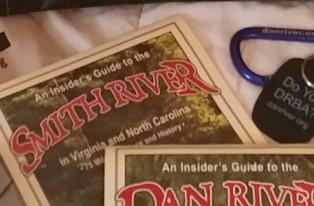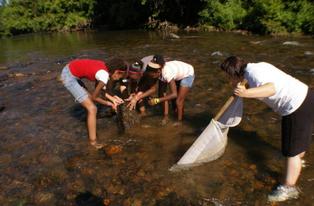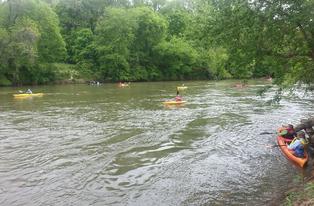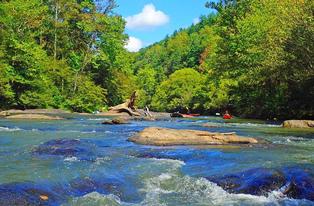
Be Safe Outdoors
Cooler weather has arrived and if you plan to hike or paddle, please be sure to prepare before you head out on your adventure!
Some tips:
- Dress in layers: Start with a moisture-wicking base layer, add an insulating mid-layer, and finish with a windproof and waterproof outer shell.
- Wear proper materials: Choose wool or synthetic clothing, as they retain warmth even when wet, unlike cotton.
- Protect from the elements: Wear a hat and cover exposed skin to prevent heat loss and windburn.
- Bring extra gear: Always pack extra clothes, especially a dry set of clothes in a dry bag, along with a first-aid kit and a protected cell phone or weather radio.
- Stay hydrated: Drink plenty of fluids, even if you don't feel thirsty.
- Pack hot drinks: A thermos with a hot drink can provide warmth and comfort.
- Eat regularly: Consuming calories helps generate body heat.
Some extra paddling advice:
- Layer up with insulation: For paddling, wear insulating layers underneath your wetsuit or drysuit.
- Neoprene gloves, booties, and a hood are also helpful.
- Dress for the water temperature: Always dress for the water temperature, not the air temperature, as you are at high risk for hypothermia if you fall in.
- Wear a PFD: Always wear a life jacket, even in cold weather.
- Check water conditions: Before heading out, check water levels and for potential ice jams, especially as temperatures drop
Trail Safety
Using trails is a great chance to experience nature, history, and get exercise. Here are some safety tips to ensure that your trip is an enjoyable experience.
DRBA'S RIVER AND TRAIL SAFETY WEBINAR, CLICK HERE
For All Trail Users
- Trails are available from sunrise to sunset every day unless otherwise marked at the trailhead.
- Before you leave for the trail, make sure you know where you are going. It is also a good idea to tell a responsible person about your plans of where you will be and when you expect to return.
- Check the weather forecast before you leave for your destination so that you can pack the proper equipment.
- Before you leave your vehicle, make sure all valuables are out of sight and make sure you lock your doors.
- If possible, park in a well-lit, heavily traveled area.
- Carry identification that includes your name, phone number, pertinent medical information, and emergency contact information.
- Know the regulations and obey all trail rules posted at trailheads.
- Stay on designated trails.
- Be cautious of poisonous plants, insects, arachnids, and animals.
- Make sure you bring drinking water and stay hydrated.
- Please leave plants and animals undisturbed.
- Any trash that you create, please make sure it finds its way to a trash can.
- Trust your instincts; don't walk where you are uncomfortable.
- Be aware of your surroundings and others around you.
- Pets should be on a leash.
For Trail Walkers/Hikers
- If you are in a group, do not block the trail to other users.
- If a person approaches you that is traveling faster than yourself, step aside and let them pass.
For Bicyclists
- Wear a helmet.
- Give a verbal warning and use caution when passing others on the trail.
- Follow the traffic laws for biking on paved trails and when on the road. Stay to the right unless you are passing others.
- Travel at a safe speed at all times. Approach turns with caution as if someone was around the corner. Use verbal warning to let people know you are coming around a turn.
- When approaching horses from behind, let the rider know you are there. Ask the rider if it is safe to pass. Some horses spook easy, and you do not want to danger the rider or yourself. When approaching an oncoming horse, stop and pull off the downhill side of the trail and let the horse pass.
For Equestrians
- Wear a helmet.
- Travel at a safe speed at all times. Approach turns with caution as if someone was around the corner. Use verbal warning to let people know you are coming around a turn.
- Let other trail users know when it is safe to pass you and your horse.
River Safety
Paddling is a great way to experience nature and get exercise. There are several important things that you must know before you get out on the water. Safety is everyone's responsibility and should not be taken lightly. Accidents can happen on any type of water. It is important to review safety guidelines before paddling and to learn the appropriate techniques need to safely navigate the water.
Know Your Flows
A good way to know river conditions is by checking the USGS flow gauges that are located on major rivers and understanding how the cubic feet per second (CFS) or the water in feet relates to safe or dangerous paddling levels. Here is a link to the USGS mobile data site: https://m.waterdata.usgs.gov/
The National Weather Service also has gagues on local waterways: https://water.weather.gov/ahps2/index.php?wfo=rnk
MAYO:
SMITH:
DAN:
Here is a link to a YouTube video explaining how to use the USGS site: https://youtu.be/eTOQRbamrSo
Additionally, there is a phone app called "River Data" that allows you to see real-time data from the USGS sites in an easy-to-understand format and allows you to save favorites.
Dams
There are several large and small dams on the rivers in the Dan River Basin. Although you can portage around most they are hazardous and should be avoided. This video will give you an introduction to Lowhead dams
Here are some safety guidelines to remember while you are on the water.
- If it is your first time on the water, take an on-water course or travel with an experienced person that has navigated that part of the river before.
- Wear your life jacket! It's always possible to capsize in any water condition. Learn how wearing your life jacket can save your life.
- Before you leave, make sure you know where you are going. It is also a good idea to tell a responsible person about your plans of where you will be and when you expect to return.
- Check the weather forecast before you leave for your destination so that you can pack the proper equipment.
- Before you leave your vehicle, make sure all valuables are out of sight and make sure you lock your doors.
- If possible, park in a well-lit, heavily traveled area.
- Carry identification that includes your name, phone number, pertinent medical information, and emergency contact information in a waterproof bag. You can also store your cell phone and camera in the bag as well.
- Know the water conditions. Sometimes the river will be high, low, or a dam may be releasing. This makes the water conditions very different and it is important to know what to expect.
- Know the rules to navigate the water. Find out what you need to know while on waterways.
- Beware of Strainers. Strainers are fallen trees; bridge pilings, undercut rocks, or anything else that allows the current to flow through it while holding you. Strainers are deadly!
- Never go boating or tubing while under the influence of alcohol or drugs.
- If in doubt, get out and scout
- Know your paddling abilities and plan your outings accordingly
- Dress appropriately for weather conditions. Carry extra clothes in a dry bag in case you flip and go for a swim. Hypothermia can be deadly
- Never float or paddle over low-head dams, avoid fallen trees and other in-stream obstructions.
- Do not stand up in a canoe or kayak, and avoid weight shifts that may cause capsize.
- Carry a supply of food and water adequate for your trip length.
- Avoid weather or water conditions beyond your skill level.
- Learn rescue skills necessary to assist others.
- Plan for emergencies: carry basic first aid.
- Inform others of your trip plan.
- Leave No Trace and Wildlife Ethics
- Leave the river and shoreline cleaner than you find them.
- Leave rocks and plants as you find them.
- Carry out your trash.
- Respect wildlife; stay clear of nests, dens, and rookeries. Human food is unhealthy for wildlife. Please do not share your food with animals.
- View a list of helpful safety tips for the next time you go on the water.
- Make sure you bring drinking water and stay hydrated!
- Know Your Limits! Make sure you know what you can endure before you leave the shore.
- View the River Paddler's Guide to Rescue.
- Learn more useful tips when scheduling your next trip.
In normal, moderate conditions, any moving water can capsize a canoe or kayak that accidentally leans upstream, something that happens easily and often without warning. The faster and more turbulent the water, the more quickly this can happen. In addition, most recreational streams contain obstacles and in flood conditions, many more are washed in. These are generally difficult to deal with when the water is running high and fast.
Disclaimer: This information is used entirely at the reader's discretion, and is made available on the expressed condition that no liability, expressed or implied, is accepted by the author or publisher or any of its associates, employees, branches, or subsidiaries for the accuracy, content or use thereof. River channels are dynamic features and thus change frequently. The boater must be aware that hazards exist and be wary of them. Paddling poses significant potential hazards including risk of injury or death, and each person participating in this activity needs to understand the risks involved, obtain the necessary training and take all the needed precautions. This guide provides general information on the topic of paddling. By providing this information, we do not assume any liability for the use of this information.
River Etiquette
- Obey all rules and regulations. Respect private property.
- Be considerate of others. Give fisherman a wide berth.
- Avoid taking disposable containers; take it in, take it out.
- Please do not litter. Do your part to keep the river clean
- So the next person can have the same experience.












